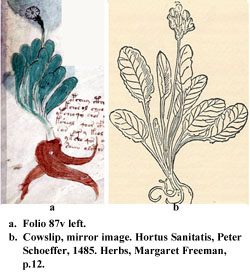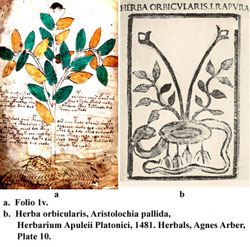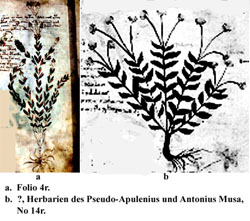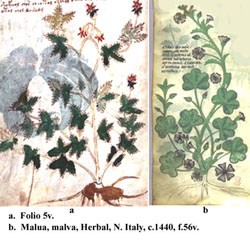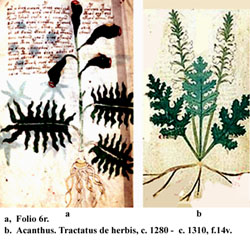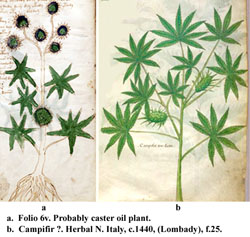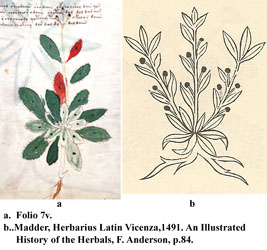The Voynich Botanical Plants
Folio 52v. Heliotrope (Heliopropium). These plants turn their rows of flower heads with the sun. Porta in Phytognomonica classified heliotropes with a scorpion because its curved flower spike resembled a scorpions tail. (A)
Folio 53v. Hawkweed (Hieracium aurantiaca). This plant is used as an astringent and for reducing catarrh and in the treatment of whooping cough, asthma and bronchitis. It contains a blood thinner similar to coumarin, an antibiotic against brucellosis and a compound found in sun screen. It is a powerful diuretic. (1) (A)
Folio 55v. An unknown plant. (A)
Folio 87vleft. Cowslip/primrose (Primula veris). Banckers Herbal says that “if the juice of the primrose is put in a man’s nose it will destroy the megrim.” The cowslip was often called Herba paralysis because it was believed to be good for “the gouty and palsy folk and them that fall of the high evil called epilepsy.” The Vertouse Boke of Distyllacyon states that “the distilled water from the cowslip is good against the pain in the head … coming of cold … biting of mad dogs and for women that beareth child. Also the face often washed therewith withdraweth the spots and pimples in the face and causeth the skin to be fair.” (2) (A)
Folio 1v. Herba orbicularis. According to the notes of Dr. W.O. Hassell (Herbal, MS Bodley 130 C. 1100, The Bodleian Libraary Oxford), herba orbicularis is Aristrolochia pallida. Cicero claimed that the plant was named for an unknown Greek called Aristolchos who had learned from a dream that the plant was an antidote for snake bites. (1) Neither drawing looks much like the plant known today as Aristrolochia pallida. (B)
Folio 4r. An unknown plant. (B)
Folio 5v. Mallow (Malva sylvestris). The flowers, leaves, and roots are edible and the Romans considered dishes made from mallow a delicacy. “A plaster made from mallow and sheep’s tallow was good for the gout. Sodden with vinegar and linseed it helped the wicked gatherings that be endangered in a man’s body. More over it kept witches away from one’s house.” (2) (B)
Folio 6r. Bear Breeches (Acanthus mollis) is native to Southern Europe and one of the earliest garden plants to be cultivated. Romans used scrolls and the leaves from the Acanthus plant to decorate the Corinthian columns. The mucilage from the plant has traditionally been used to treat burns and dislocated joints. (Encyclopedia of medical plants) (B)
Folio 6v. Caster oil (Ricinus communis). The seeds are very toxic due to the presence of the protein ricin. A dose of ricin as small as a few grains of salt can kill a man so great care should be taken when handling this plant. The heat process used to extract the oil from the seeds destroys the ricin. Caster oil seeds have been found in Egyptian tombs. The Greeks used the oil to anoint their bodies. Castor oil is used medicinally as a laxative and a purgative. (1) (B)
Folio 7v. Madder (Rubia tinctorun). Madder was used as a diuretic, for stomach ailments, hysteria and amenorrhea and complaints of the liver and spleen. Its principal use was the pink, rose or crimson dye obtained from its roots. The color depended on the mode of extraction and the mordant used to set the dye. (An Illustrated History of Herbals, F. Anderson, p.84.) (B)



